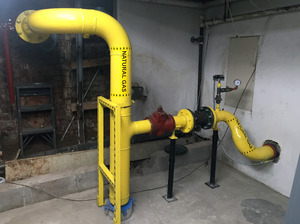 NYC Local Law 157 requires natural gas alarms in residential buildings to enhance safety and protect occupants from gas leaks.
NYC Local Law 157 requires natural gas alarms in residential buildings to enhance safety and protect occupants from gas leaks.
Enacted after several deadly gas explosions in New York City, Local Law 157 of 2016 (LL 157) requires natural gas alarms in all residential buildings with gas service to improve safety and reduce the risk of gas leaks. Building owners, property managers, and boards must comply with these regulations to avoid penalties and maintain occupant safety.
What Are the Requirements for Local Law 157 Natural Gas Alarm Compliance?
LL 157 is a key component of New York City's gas safety initiatives, requiring natural gas alarm installations in all residential buildings with gas piping. This includes:
- Private dwellings – Single-family homes and similar residences.
- Class A multiple dwellings – Permanent residential buildings like apartments, condos, and co-ops.
- Class B multiple dwellings – Transient-use buildings such as hotels, dormitories, and single-room occupancies (SROs).
The law follows the National Fire Protection Association (NFPA) 715 Standard, mandating that the detection and warning equipment comply with safety standards.
How to Properly Install Natural Gas Alarms for Local Law 157 Compliance
Location & Placement:
- At least one natural gas alarm must be installed in each dwelling unit.
- In rooms containing fuel-gas-burning appliances, alarms must be placed between 3 to 10 feet from the appliance.
- Alarms should be installed on the ceiling or within 12 inches of the ceiling if placed on a wall.
Alarm Specifications:
- Must be compliant with UL 1484 or UL 2075.
- Must be maintained in working condition.
Installation by a Qualified Professional:
- Alarms hardwired to electrical systems must be installed by a licensed electrical contractor.
- Battery-operated or plug-in models may be installed by property owners, maintenance staff, or occupants.
When Is the Deadline for Local Law 157 Natural Gas Alarm Installation?
The original deadline of May 1, 2025 has been postponed. Enforcement will now begin no earlier than January 1, 2027, and only if the NYC Department of Buildings confirms there are multiple compliant alarms available on the market. If those requirements aren’t met by mid-2026, the start date could be pushed back further
Buildings without gas piping or service are exempt.
Recent Local Law 157 Amendments: How They Impact NYC Buildings
A significant amendment extended the deadline for allowing monitored battery-powered natural gas alarms in existing buildings. The key change is:
- Originally, only buildings constructed before January 1, 2024 could install monitored battery-powered alarms.
- Now, buildings constructed before January 1, 2025, can still use battery-powered alarms instead of requiring hardwired units.
This extension provides flexibility for projects already in progress, allowing them to comply without retrofitting for hardwired alarms.
What Are the Warning Signs of a Natural Gas Leak?
Being able to spot the signs of a natural gas leak is essential for preventing serious hazards. Some key warning signs to watch for include:
- Smell: A strong odor of rotten eggs (added by gas companies as a safety measure).
- Sound: Hissing or whistling noises near gas lines or appliances.
- Sight: Bubbling in standing water, dead vegetation near gas lines, or visible mist escaping from a pipeline.
- Health Symptoms: Dizziness, headaches, nausea, or difficulty breathing when indoors.
If you suspect a gas leak:
- Do not use electrical devices or light switches, as sparks can ignite gas.
- Open windows and doors to ventilate the area.
- Leave the building immediately and call 911 or your gas provider from a safe distance.
Related Services
RAND offers a range of services that support compliance with LL 157 and gas safety, including:
- Gas Piping System Assessments & Upgrades – Evaluating existing gas infrastructure, identifying risks, and designing code-compliant upgrades.
- MEP Engineering for Gas Systems – Integrating gas system modifications with mechanical, electrical, and plumbing components for a coordinated building approach.
- Code & Zoning Compliance – Navigating DOB requirements and maintaining adherence to regulatory standards.
Further Reading & Resources
For more details on Local Law 157 compliance and requirements:
